England: Vocational and Technical Qualifications in Computing at the end of Key Stage 4 and 5
Background and context
There are 599 VTQ’s at Level 2 and 3 registered in England with Ofqual (27) although only 97 of these (46 Level 2 and 51 Level 3) are currently operational. These are offered by 12 awarding organisations. There are a further 26 registered awarding organisations with qualifications that are no longer operational.
In 2020, the most popular award at Level 2 was the Pearson Edexcel Level 2 Certificate in Digital Applications (1,024 awards) and at Level 3 it was the City & Guilds Level 3 Award in Business Processes (405 awards). 45 VTQs had no students being awarded a qualification - almost half of the number registered. The current Level 2 and 3 awards that are still eligible for entry and assessment are included at Annex 3.
The DfE recognises three types of vocational awards for reporting purposes. These are described below:
Technical awards
These broad level 1 and level 2 qualifications are designed to provide students with applied knowledge and associated practical skills which may not be available in a more general educational option. It is possible at key stage 4 to take up to three technical awards, often in combination with at least five academic GCSEs from the list of EBacc subjects[28].
Technical awards in the Information and Communication Technology category are subject to a no-overlap rule with the Computing KS3 Programme of Study and the Computer Science GCSE subject specification.
Technical certificates
These level 2 qualifications provide post-16 students with the skills and knowledge required to advance to skilled employment and/or further study.
T levels
These level 3 T-levels follow GCSEs and are designed as equivalent to 3 A-levels, they have their origins in the 2016 Sainsbury Review of Technical Education[29]. They have been developed with employer support and are aimed at post-16 students wishing to specialise in a specific industry, occupation, or technical role.
They had a phased introduction started in September 2020 which included digital production, design and development with first certifications in Summer 2022. The digital business services and digital support and services T-levels began in September 2021.
Knowing what counts and what does not in the Department for Education performance tables is important. In the 2019 versions of the tables and subsequently, the European Computer Driving Licence (ECDL, BCS) has been dropped from inclusion at Levels 2 and 3. Many other vocational qualifications have been discontinued since the Wolf report of 2011[30].
Understanding and interpreting the uptake and attainment data regarding VTQs in England is challenging and requires greater support from the DfE for this to happen.
There are two main issues with the current VTQ data:
- Relevant demographic information isn’t captured effectively restricting policy makers’ ability to make informed decisions around such issues as socioeconomic status and ethnicity
- Inconsistency in the existing data sets across years. For example, Level 2 data has been produced with a female and male breakdown in the past two years, but not beyond that. At Level 3, subject level data is aggregated at a very high level, but there is inconsistency over reporting results by gender
The college sector, of course, includes general further education and there are qualifications and data that allow us to examine what level of uptake of qualifications there is in this sector. As this information is drawn from the FE sector, it is not immediately clear that it excludes school-level information set out in the performance tables.
In the school and college sector, the most reliable source of data is the DfE’s performance tables data. Currently, these reports at KS4 and 16-18 include a range of VTQ’s. These include the Technical Awards, Technical Certificates, and T Levels[31] described earlier.
The awards included currently in the DfE performance tables (and part of this analysis) are set out in Annex 3 and the data presented here is in the public domain and can be accessed at the sources listed in Annex 4. These datasets are current up to and including academic year 2019/20.
There are other computing related vocational technical awards such as OCR Level 1/2 Cambridge National Certificate in Creative iMedia which are not categorised by DfE as Information and Communication Technology and therefore fall out of the scope for this report.
However, a significant number of candidates take related qualifications such as these, in 2021 more than 42,000 candidates took OCR Level 1/2 Cambridge National Certificate in Creative iMedia, which is categorised in Arts, Media and Publishing. Schools' reasons for offering these alternative qualifications warrants further investigation.
Participation and attainment
The data presented below comes from a variety of sources. Some of this is drawn from DfE school and college performance data, whilst some is drawn from the Ofqual qualifications records. The overlap and comparability of the data sets requires further investigation, and there is a distinct lack of consistent public reporting by simple measures such as male:female participation.
The patterns of uptake over the last five years for these qualifications is erratic with no clear trends and some unexplained declines in some areas - Level 2 digital applications or Level 3 Coding and logic for example.
These declines may simply be a reflection of the market currency of VTQs and the possible greater volatility of qualification uptake when they are closely linked to employer needs. The 2020 data may also reflect a loss of engagement as a result of the COVID-19 pandemic and the data may include adult learners reiterating the need for much better quality data.
VTQ data from Ofqual
The following charts show the VTQ uptake across five years in Level 2 and 3 qualifications. It is not possible to determine any patterns in the uptake separately by males and females.
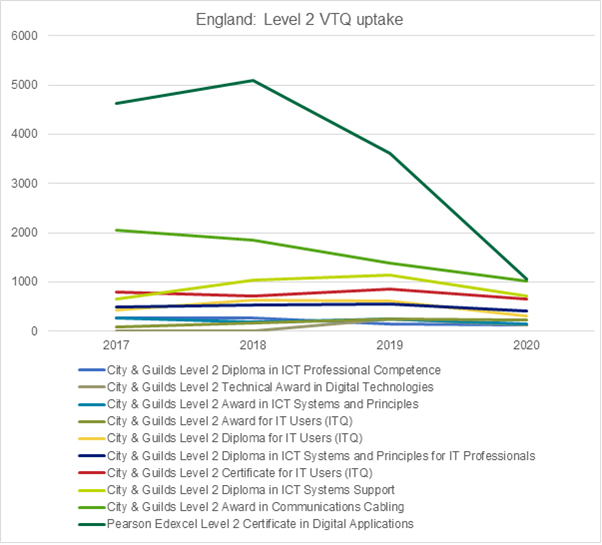
In 2020, the equivalent GCSE and A-level entries (for Computer Science) were 75,791 and 11,608 respectively in England. None of the VTQs examined here are in any way comparable in terms of size of uptake to their academic equivalents. The low numbers of VTQ entrants is very likely a reflection of the removal of a number of extremely popular qualifications from the Performance Tables following the Wolf Review.
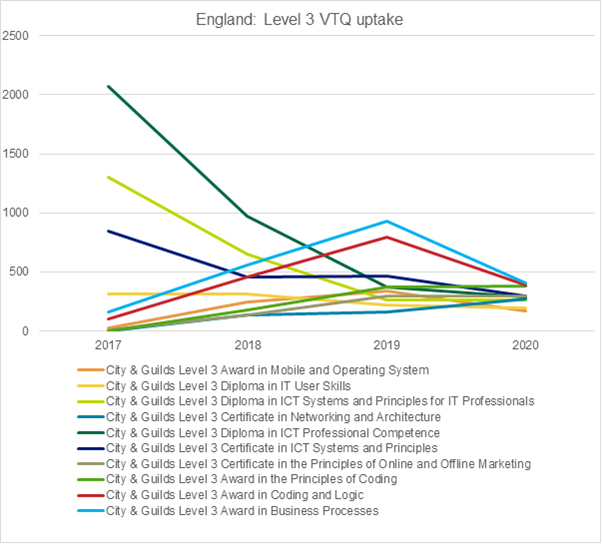
In 2020, the three most popular Level 2 and Level 3 awards were as follows:
| Award | Number |
|---|---|
| Pearson Edexcel Level 2 Certificate in Digital Applications | 1050 |
| City & Guilds Level 2 Award in Communications Cabling | 1025 |
| City & Guilds Level 2 Diploma in ICT Systems Support | 715 |
| City & Guilds Level 3 Award in Business Processes | 405 |
| City & Guilds Level 3 Award in Coding and Logic | 390 |
| City & Guilds Level 3 Award in the Principles of Coding | 380 |
In 2020, the equivalent GCSE and A-level entries (for Computer Science) were 75,791 and 11,608 respectively in England. None of the VTQs examined here are in any way comparable in terms of size of uptake to their academic equivalents.
It has not been possible to aggregate data across the Level 2 or Level 3 qualifications to identify the number of unique students who gain a computing or digital qualification at the end of key stage 4 or 5.
Vocational awards from the Department for Education data
The following charts show the uptake of vocational qualifications that can be discerned from the School and College Performance tables and related statistical first releases. The sudden drop in 2017/18 is a result of the plan to remove the ECDL from the DfE Performance Tables.
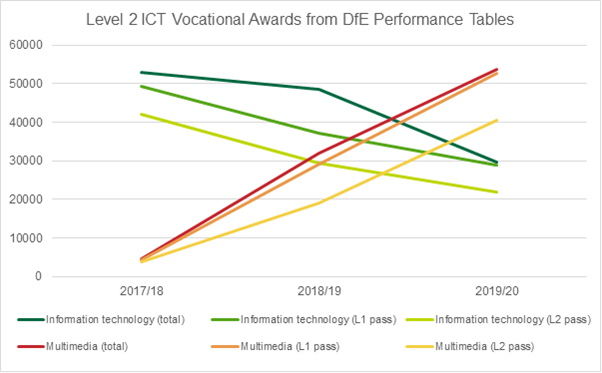
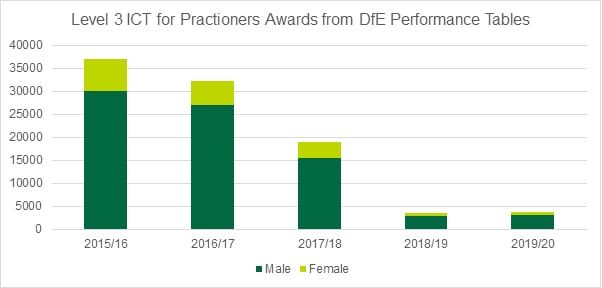
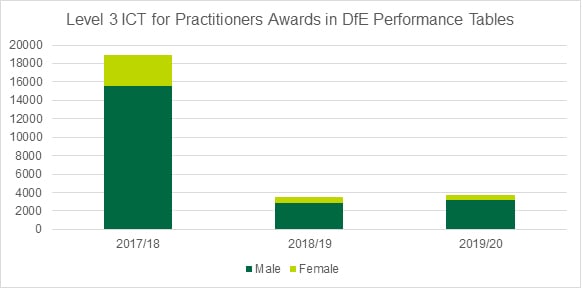
Typically, at Level 2, the ratio between male: female participation and awards is 1.9:1.0, whilst at Level 3 it is around 5.0:1.0, suggesting a strong decline in female student engagement post-16.
Some context
The Computer Science A-level was reformed in 2015 and from 2016, the DfE replaced the GCSE in Information and Communications Technology (ICT) with the GCSE in Computer Science.
The UK Government’s 2017 Digital Skills Strategy[32] celebrated this change and drew attention to the support being offered to underpin the new curriculum, including the contributions being made by providers of informal support and enrichment activities. This was followed up by the autumn 2017 budget[33] announcement of an £84m investment in Computer Science teachers, with the aim of upskilling 8,000 individuals (to become qualified Computer Science teachers).
The loss of any computing-rich options beyond key stage 3 (KS3) in England other than GCSE Computer Science causes concern and there is little to suggest that VTQs are currently seen as alternatives being effectively promoted as options or complements to the current system[6]. Of particular concern is the shift in male and female student participation highlighted by studies such as[24], something which may not be helping with diversity in higher education Computer Science (where the ratio of male and female undergraduates in is over 4:1)[34].
The Royal Society[7] points to concerns about teacher supply. The shift from ICT to computing placed demands on existing teachers to deliver a new curriculum, prior to any new supply of dedicatedly trained teachers. Whilst dedicated teachers are entering the system, and CAS and the NCCE address upskilling, there continue to be issues with the spread of the subject across schools and with the supply of skilled practitioners.
If computing teacher supply bears any relationship to that of other STEM subjects, then there is evidence of persistent supply issues in schools serving disadvantaged communities[35]. Improved data quality on the supply of computing and digital teaching skills in the further education sector is needed before accurate conclusions can be made.
The NCCE recently released its first impact report[36], setting out the scale and range of the programme and achievements. In two years, it has developed a comprehensive suite of learning materials and development opportunities for teachers in England across the primary and secondary phases. School participation rates tell us that 78% of secondary schools and just over 50% of primary schools have engaged with the NCCE.








